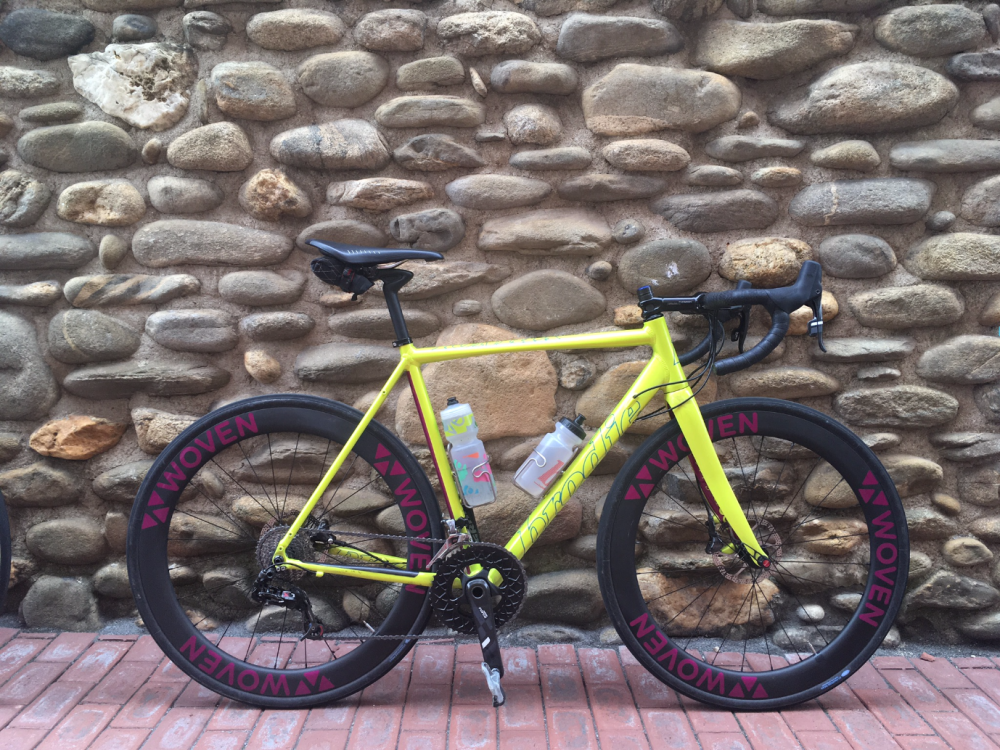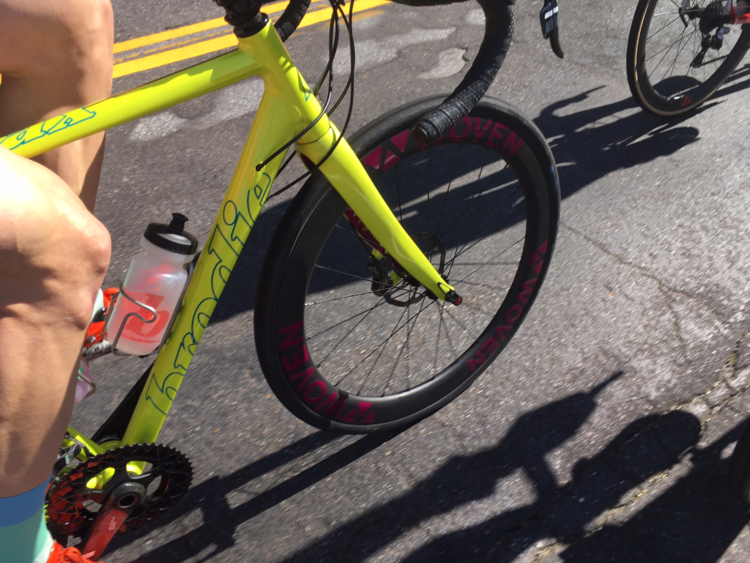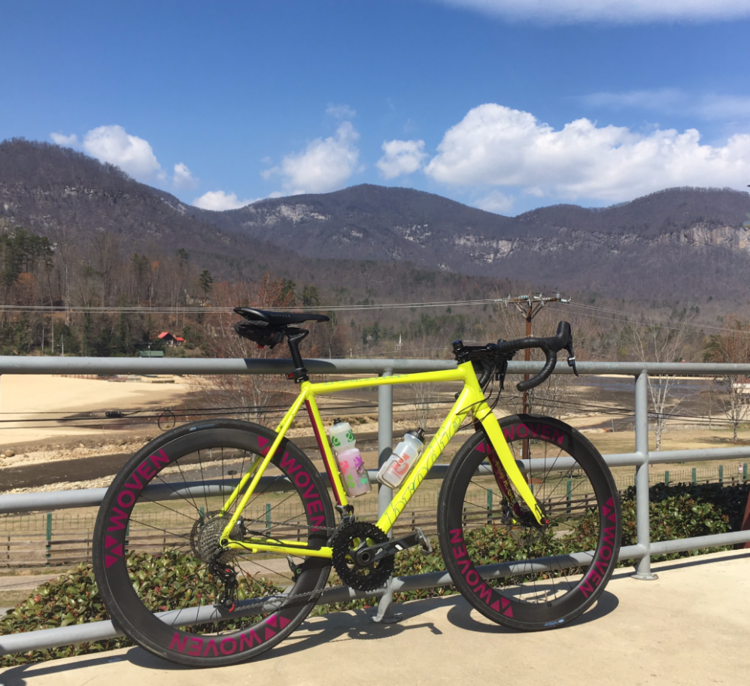Oval Revolution: 1000km on Absolute Black's Oval Road Rings
There's no denying that oval chainrings look weird. Shimano's Bio-Pace foible a couple decades ago almost relegated oval rings to the recesses of history alongside other gimmicks. . . almost! While Shimano missed the mark in the phasing of their oval rings (rotation of oval peaks in relation to pedals), companies that have followed up with their own designs within the last decade or so have significantly improved on the concept. Rotor was one of the first to reintroduce ovality to chainrings, and I was quite happy with the performance of a set I used on my 29er mountain bike for a couple seasons. I happened to ride some very good races on those rings, and after using round ones for the preceding years due to a crank incompatibility, I couldn't shake the feeling that I was missing something. - Originally published in 2017
In 2016 Absolute Black provided me a 34-tooth oval ring for my cyclocross bike while in gravel-mode, two chainrings. I rode the ring around home for a while with no issues or revelations for a while before heading to Vermont for the Vermont Overland dirt road race. It was then that I was amazed by the improved climbing rhythm the small ring provided. After riding at my limit to try to hang on to the best climbers in the race over relentless off-road climbs, I shifted to my round big ring atop a climb and felt like I was pedaling squares! I shifted back to the small ring, and used if as much as I could from there, as I was simply riding more rhythmically and smoothly in the oval ring. Amazed, I decided I really wanted to try using them as a pair in 2017.
Fortunately, Absolute Black was kind enough to officially add me to their roster of sponsored riders for 2017, and I was thus able to get a pair of their Premium oval road rings for my SRAM Force crank. Sure, I ordered the wrong set, not realizing the SRAM crank uses a hidden chainring bolt spider, which places the oval rings off-rotation, but we sorted that out and I was able to mount the correct rings to my new Brodie Romax cyclocross/gravel bike in time for our training camp in South Carolina the second last week of March. In this post I'll cover an overview of the rings, set-up, shifting performance, pedaling performance and conclusions following 1087 kms on the rings.
Overview - Premium OVAL Road Rings for SRAM $124/$62 USD
As mentioned above, AB offers a Shimano and SRAM version of their Premium oval rings, which are impeccably and intricately machined out 7075 Aluminum with Type II anodizing. This alloy feels good in the hands, and the recessed in the big rings' outer face and small ring's inner face sheds a lot of material while retaining a structure that appears to increase structural integrity.
AB offers these rings in configurations that fit most cranks, including Shimano Dura-Ace 9000, Shimano Dura-Ace 7800, 7900, 7950, Ultegra 6700, 6750, 6800, Shimano 105, 5700, 5800, Tiagra 4600, 4650, 4700, FSA, Rotor 3D & 3D+, S-works, Sram Red, Red eTap, Red22, Force1, Force22, Rival, Rival1, Apex. The Premium rings are compatible with Quarq, Di2, Pioneer, SRM and other power meters, and depending on bolt pattern, available in 34, 36, 38, 39, 50, 52 and 53 teeth.
For Shimano's hidden bolt cranks, such as current Ultegra and Dura-Ace models, AB makes beautiful bolt covers/nuts that maintain beautiful aesthetics.
At a lower price point, AB also offers Winter Oval Road Rings, which reduce costs by using less weight-saving machining, while using of the same quality alloy, anodizing, and shifting ramps. These would be a good option for those riding in gritty conditions not caring about weight as much as value.
Advantages of Absolute Black Road Oval chainrings:
The following are the benefits AB claims their oval rings will deliver. I will address each of them in my conclusions:
One of a kind special oval shape that helps you climb easier and faster (Patent Pending)
Over 15% stiffer than Rotor Qrings due to thicker, 5mm construction
Bespoke Absolute Black 6 point ramp and recess shifting design shifts better than any other brand and model of oval chainring
Finest design that provides excellent strength to weight ratio
You will not "feel" the oval shape while pedaling
Your pedaling action will feel smoother
Helps reduce stress on knees and helping your legs remain fresher for longer
You will be able to maintain better cadence while climbing
Reduces possibility of leg cramps
You will reduce chainring/cog shifts by at least 15%.
Installing and tuning
I was apprehensive about two things: dropping chains when shifting, chain slap. I've dropped chains at inopportune times in races in the past - who hasn't? - so was a little worried about this potentiality. In order to reduce the likelihood of this occurring, knowing it tends to be more common on rough terrain than smooth roads, I built my Romax with my favoured SRAM XO clutch mountain bike derailleur. I've been using this derailleur with two rings and single rings for a couple years, and it works exceptionally well with SRAM 10 and 11-speed shifters. You read that right, both 10 and 11! It's a mountain bike derailleur, upgraded with Kogel's narrow-wide 12-tooth pulleys, which help maintain chain alignment. Absolute Black also makes narrow-wide pulleys. The clutch derailleur (this means the derailleur cage is under very stiff spring tension, which keeps the chain wrapped around the rings tightly) helps on the chain-slap front too, something I experienced on my 29er. The 'low' shape of the rings in coasting position positions the chain closer to the chainstay while in the middle ring than usual. With my 32t ring and clutch derailleur, chain slap doesn't seem to be an issue whatsoever, and I don't expect this to change.I mounted my 34 and 50-tooth rings to my SRAM Force crank without issue. When doing so, be sure to grease your bolts, especially when they are alloy!Having sized my chain (Shimano 105 11-speed) length as usual (wrap big ring, big cog outside derailleur, add two full links), I mounted the SRAM Force YAW front derailleur chose for my build, my first time working on a YAW. Accustomed to setting up conventional designs, I naturally screwed up my initial adjustment, and resorted to reading instructions. I learned that there are hashmarks on the derailleur's cage, front and rear, which must be aligned over the chainrings. Once I made this fix, shifting went from poor to terrific. Paired up to a Shimano Ultegra 11-32 11-speed cassette, shifting was spot on in the stand.
Shifting Performance
Our training camp in South Carolina was the perfect testing ground for my new bike and the Absolute Black rings. In the Ottawa-Gatineau region I can use my 50t chainring to cover most climbs, so shifting to the small ring only happens once or twice most rides, if at all. In South Carolina we were all over our front shifting, and the 34/50 pairing highlighted the benefit of using an 11-32 cassette, as I was able to remain in the 50t while Dave Jones, also on the 34/50 AB ovals, had an 11-27 cassette that forced him to shift to his small ring far more often. His rings got a huge workout!Dropping to the small ring was always perfect, and my SRAM drop-stop was never required to do its job. Shifting to the big ring varied from perfect to a little clunky, depending on how much load I had on the pedals, the gear I was in on the back, and the timing of the shift. I learned how to time my shifts at different cadences to yield the smoothest shifts, never dropping the chain.Ultimately, I would rank the shifting performance as on-par with my Dura-Ace rings and slightly better than my Ultegra 4-bolt rings. This could come down to the YAW versus regular front derailleur in the case of the Ultegra rings, hard to say. The main point is that I have no issues or concerns about the shifting performance, and this is without a wedge in the front derailleur braze-on mount that other brands recommend for use with their rings, to change the alignment of the front derailleur. AB states this is not required, and I agree.
Pedaling performance
This is where the rubber meets the road, the one question every reader will want answered: are these oval rings worth switching to?Yes. I believe they are. However, since there is no one set-up that is for everyone, I'll caveat my endorsement.
Pedaling on flat ground, at around 85 rpm cadence is smooth, and feels good for pedaling economy.
Caveat: It will take some time for most riders to become accustomed to the difference in pedaling rhythm. The more you ride, the longer it'll take. It took me two days, about 9 hours of riding, to no longer notice the rings on flattish terrain.
Caveat: At high tempos over rapidly varying grades, it could feel a little awkward to stay on top of the gear at high cadences (95 and over). I find that this terrain is ridden best around 85 rpm, so that the dips don't see cadence come up high enough to feel awkward. This could be something that will disappear if one only rides oval rings, but would likely take longer if switching between round and ovals, as I do. If my experience is an indication, the brain is capable of adapting exceptionally well to things like this when given enough time.
While climbing, the oval rings work exactly as advertized. Why is there a difference? Climbing requires different muscle recruitment and technique than flat and downhill riding, mostly because of the constant tension on the pedals, but also because of the change in body angle relative to the road surface.
Sitting and spinning up the Carolinas' climbs, which were as long as 37 minutes of steady ascension, I felt smoother than ever and economical. By economical, I mean my legs were not fighting each other as I spun the pedals. Think about how your legs move in opposing ways as you pedal if you don't quite know what I mean.
Climbing standing was outstanding. I was able to test this thoroughly in both small and big rings, and it worked equally well in both. I quickly realized that I could get into a rhythm with my hip movements that allowed me to focus power transmission from my glutes rather than my quads.
The ovality of the rings seem to allow me to 'fall' onto the rings more than with round rings, and the 'low' phase of the ring helps swing through the dead spot of the pedaling rotation to get onto the next pedal stroke. After a few days riding, I decided to climb Caesar's Head out of the saddle to really test both bike and body. The first 20 or so minutes felt smooth and fairly easy, strangely similar to walking up stairs, just less effortful. As Aaron Kyle and I neared the last phase of the climb, we upped the pace, and I wasn't able to continue to use my smooth, mostly-glutes technique. Instead, I had to rely on my quads, and after 10 minute of that I was looking for the top! 37 minutes climbing out of the saddle, a new PB, and no pain in the legs the next day. I consider that a successful test. They're also great for doing wheelies!
Conclusions
I'll go through each of Absolute Black's claims, and provide a yay, nay, or inconclusive.
One of a kind special oval shape that helps you climb easier and faster (Patent Pending)
Yay. I feel the rings do indeed help me climb easier and therefore, faster (when desired).
Over 15% stiffer than Rotor Qrings due to thicker, 5mm construction
Inconclusive. There's no way for me to substantiate this claim. All I can say is the rings feel completely stiff enough, and don't seem to deflect under shifting load. They also run straight.
Bespoke Absolute Black 6 point ramp and recess shifting design shifts better than any other brand and model of oval chainring
Inconclusive. I've not tested the others, but shifting is very good, and it's hard to improve on that.
Finest design that provides excellent strength to weight ratio
Yay. The first part is subjective, but I would agree that these are the best looking oval rings on the market, and their strength to weight ratio is evidently excellent.
You will not "feel" the oval shape while pedaling
Yay and nay. On flat terrain, expect to feel the oval shape at least for a short time. On climbs, expect not to feel the ovality, even from day one.
Your pedaling action will feel smoother
Yay, at least most of the time, then likely all of the time.
Helps reduce stress on knees and helping your legs remain fresher for longer
Yay. I believe the rings do help improve muscle economy, provided you let them help you.
You will be able to maintain better cadence while climbing
Yay, both while seated and standing.
Reduces possibility of leg cramps
Yay. If you are damaging your legs less because you are pedaling with greater economy, you are reducing likelihood of cramping.
You will reduce chainring/cog shifts by at least 15%
Inconclusive. I agree that the ovality helps pedal smoother across a broader cadence range than round rings, but can't say how much more. In order to reduce shifts, at least up front, make sure you use a broad enough cassette for your terrain. Around Ottawa-Gatineau I like to use an 11-28 for road riding; horses for courses.
Final Conclusion
While I acknowledge that I am subject to perception biases just like everyone else, which could account for the feelings I experienced while riding the Absolute Black oval road rings, when I look at a couple data points - knowing I wasn't in South Carolina to chase KOMs - I feel the performance I realized over the 7 days of riding (36hours) was very solid. In addition, my recovery from day to day was excellent, which suggests I was not damaging my legs. The fact that I was able to climb out of the saddle for 37 minutes without sitting suggests that the rings support muscle economy well (to learn about muscle economy, check out this great VeloNews podcast). Check out Absolute Black's video about third-party testing conducted on the rings' effectiveness from a power delivery (force effectiveness) and oxygen consumption and ventilation perspective.
Overall the idiosyncrasies I discuss above are easily overshadowed by the improvements over round rings I feel the Absolute Black oval rings offer. I am 100% happy with my choice to spec them on my bike, and I will definitely switch to them on my road bike when I have the opportunity. For this year's cyclocross season I will use Absolute Black's direct mount CX1 oval narrow-wide traction rings (what a mouthful!) on both my Brodie Romax race bikes, which I am really excited about. More than pedaling economy, I'm keen on them delivering an improvement in traction by virtue of the smoothing of power transmission they promise. Given my experience with oval rings on my mountain bike and more recently on my Brodie, I expect to really enjoy using the direct mount rings through the summer on my B-bike, and through race season on both. My time on their round narrow-wide rings over the last two seasons proved that their rings retain the chain almost perfectly, so I look forward to more smooth pedaling this season.
Many thanks for Absolute Black for their support! You can check them out on FaceBook, Instagram, and at https://absoluteblack.cc/
Related Posts
Down South: Old Dogs, New Tricks.Talking Gravel with Velo de Route Gearing Up/Down for Vermont Overland How to Decide Whether to Use a Single Chainring for Cyclocross Matter: Kogel’s Narrow-wide Ceramic Bearing Derailleur Pulleys Training for the Spring Classics: Whatever it Takes











